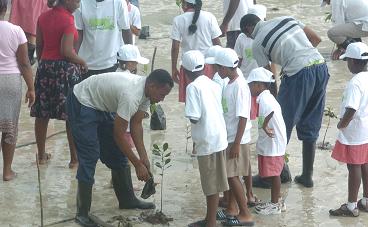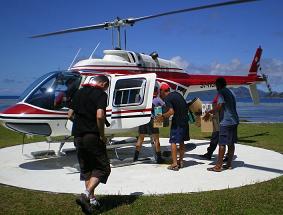2008 – Environmental protection For and By the People |31 December 2008

This is an extraordinary philosophy that not many nations have enshrined in their Constitution.
And in 2008 we saw how many environmental activities in our country captured this noble principle. An exciting and new environmentally friendly space for people was unveiled early in the year when Nature Seychelles’s Sanctuary at Roche Caiman, a wetland, was opened by the Minister for Environment, Natural Resources and Transport, Joel Morgan, in the presence of the Minister for Education. Indeed wetlands are no longer seen as wastelands in Seychelles and the country’s first Ramsar Site of International Importance was designated this year at Port Launay by the Department of Environment.
A coastal mangrove restoration project involving members of the public and children was kicked off this year by the Ministry for Environment, Natural Resources and Transport at Roche Caiman not far from the first mangrove rehabilitation by the Forestry Department back in the 1990s at the Sanctuary at Roche Caiman. This current project planted seven species of mangroves.
The regional program ReCoMap -- which stands for Regional Programme for Sustainable Management of the Coastal Zones of the Indian Ocean Countries -- initialed a school contest to increase awareness of the coastal zones. This consisted of drawing, poster and essay competitions and although not new activities for Seychelles, the prizes were extremely exciting consisting of lap top computers and digital cameras among others.
In the marine world, the Marine Conservation Society of Seychelles and the Wildlife Clubs of Seychelles with the sponsorship of Barclays Bank started a turtle tagging project whereby school children can track the tagged turtle over the internet in real time, an exciting activity sure to fire the imaginations of budding environmentalists.
Some good news for coral reefs were revealed by scientists this year compared to bad news last year. In a study between two British Universities and one from Australia and SFA and Nature Seychelles, it was shown that reefs are regenerating significantly at 31 sites observed.
The first group of 12 to 14 years old received their open water certificates after undertaking a dive course with SCMRT- MPA junior Dive Club. The aim of the club is to give the opportunity to become a qualified PADI diver and in doing so develop their interest in marine conservation.
Earth Day was commemorated with a people centered activity “My Tree Our Seychelles”, part of a global UN campaign with ministers planting at the Le Meridien Fisherman’s Cove and similar activities later in the year. NGOs also celebrated Earth Day with a learning program for Wildlife Club Leaders on the Earth Charter so as to inculcate a new set of values and ethics for caring for the earth
Rare birds were brought to more islands in an effort to make them extinction-proof. The Magpie Robin was translocated to Denis island by Nature Seychelles where the island managers had worked with the NGO to restore scores of hectares of forest. The most inspiring bird success story was the translocation of the Vev or Paradise Flycatcher from its last stronghold on La Digue to Denis, an international operation that involved Nature Seychelles, Kent University, the La Digue Development Board and the Department of Environment.
Meanwhile the Seychelles Islands Foundation has mounted vital research into the Black Parrot, the icon of Praslin. But Black Parrots may face a threat from introduced Green Parakeets, the subject of another recent study which shows that the threat from these aliens is real.
The involvement of local stakeholders was taken to another level with the initiation of social marketing. Terence Vel of the Wildlife Clubs led a year-long campaign with the University of Kent to market the conservation needs for rare birds. At the end of the campaign a survey showed a large percentage of people had been convinced by the messages and indeed gave their consent for the needed conservation actions.
Plants and People were not forgotten this year. A Public Awareness workshop led by the Eden Project from the UK aims to draw up a plan for environmental education for sustainability. In a related move the Plant Conservation Action Group, an NGO, presented a Research Agenda to the Minister for Environment which will be used as a road map for plant conservation research.
Recognizing that climate change is everybody’s business, the Red Cross organized a workshop on understanding and addressing the risk of climate change. The Ministry of Health and Social Development highlighted the cross sectoral importance of this subject by organizing a workshop on tackling health risks associated with climate change.
The natural environment gave a massive boost to Seychelles tourism image across North America when the celebrated Today Show was broadcasted live from Seychelles. The host of the longest running show on network television, Matt Lauer, talked to the President of Seychelles, Mr James Alix Michel, STB CEO Maurice Loustau-Lalanne who appeared with a giant tortoise and Nature Seychelles’ Nirmal Shah who was captured on film with a live fruit bat. The show was seen by more than 40 million viewers.
In a move to make government more of a facilitator, some environmental work is being privatized. The government has now outsourced beautification of the capital city to private contractors. As regards waste management, to reduce littering and waste the government will ban all plastic bags less than 30 microns thickness as carrier bags. A grace period is being given for all producers and traders to dispose of existing stock of these bags.
The major source of funds this year, as in previous years, is the Global Environment Facility (GEF). Several large projects being financed by the GEF was launched with assistance from UNDP. The projects aimed to mainstream biodiversity into productive sectors, managing invasive species and sustainable land management. The projects are costing about US $6 million.
Several prizes were awarded for environmental achievement. The Seychelles National Botanical Garden was named by Reuters as one of the top 10 botanical gardens to visit in the world. Nirmal Shah, Nature Seychelles’ CEO walked away with two awards -- one was the SABC Digital Highway Africa prize, an event carried live by SABC and subsequently by the BBC, as well as the African Award for Entrepreneurship in Education Country Prize. Rolph Payet, the Presidential Special Advisor, won a Global Ocean award for his work with the Global Oceans Forum.
But despite the great achievement by the government, NGOs and people of Seychelles the country is facing some dire threats and none more so than climate change. President James Alix Michel, a tireless champion on behalf of islands, spoke at several international fora about the need to protect the livelihoods, and indeed the lives, of island people. President Michel’s consistent message always has been that the Seychelles and other small island developing states are the victims not the perpetrators of global warming. We hope the world’s leaders are listening and taking note.
Contributed






